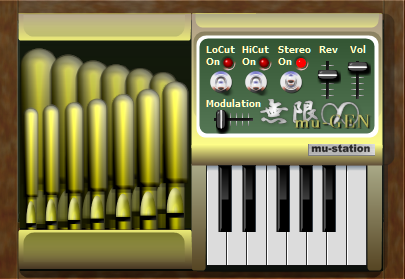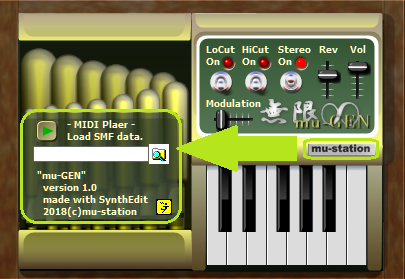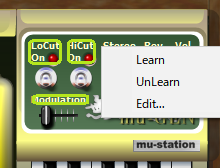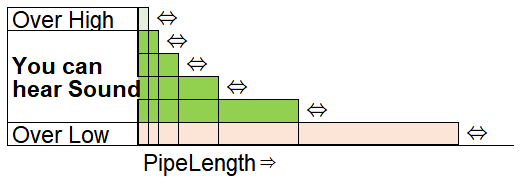
|
「mu-GEN」は単なるパイプオルガンの音を模したプラグインです。しかし、それは普通のパイプオルガンとは少し異なります。
キーボードの一番下のkey-Cから半音ずつ上がって、1オクターブ上の音に達すると、元のkey-Cと同じ音が再び鳴り、1オクターブの幅の間で無限に音が続く不思議なオルガンです。
逆の場合も同じです...上から順番に下っても下の音がまた上の音に戻ります。
学術的には「無限音階 (シェパードトーン)」と呼ばれる原理ですが、説明にはかなり時間がかかりますし、説明を聞くだけでは理解が難しいかもしれませんので、下のコラムにまかせるとして、ここではmu-GENの特徴について説明します。
mu-GENはこのような不思議な無限音階のパイプオルガンですが、パイプオルガンは元々オクターブ毎に異なる様々な長さの違うパイプが、同時に同じ音量で発音されます。それがいわゆる誰もが知っている「パイプオルガンの音」なのです。
パイプオルガンの原理から説明すると、話が長くなるので、興味があればウィキペディアや楽器メーカーのサイトなどをチェックしてみてください。
つまりmu-GENは、パイプオルガンが発音する方法をシミュレートして動作しています。 また、無限に上下する音階の音で調整して鳴っているので、1オクターブのスケールでも普通の広がりで演奏しているという錯覚を与えてくれます。
mu-GENでは、特別なサウンドを作成する機能はありません。あなたがそれを変更すると、あなたはそれを無限音階で聞くことができなくなるからです。そのため、トーンの数は少なくても、高域フィルタや低域フィルタをカットする機能と、教会で聞くようなリバーブ機能を搭載することで、パイプオルガンとして、れっきとした楽器として使えるように調整しています。
演奏に必要な鍵盤は1オクターブしかなく、音色を作る機能がほとんどなく、画面上で操作する内容が無いため、デザインを埋めるのに苦労していました。そこで、演奏した時にスケールに対応したパイプとキーボードがアニメーションするようにしました(実際のパイプオルガンパイプはそのように動くわけではありません...)。
また、キーを押しながらピッチベンドを上下に操作すると、±1オクターブ幅、合計で2オクターブ、無段階に変化できますが、上下に移動していたはずの音程が、元の音に戻ることを聞いて理解することができると思います。
"mu-GEN" is a simple plug-in simulating pipe organ sounds. But it is a bit different from ordinary pipe organ.
When you reach the sound 1octave up from the lowest key-C of the keyboard and reach the sound 1octave higher, the same sound as the original key-C sounds again, and the sound continues infinitely in 1octave width It is a mysterious organ.
The same is true for the opposite case ... even if you go down in order from the top, the lower note will return to the upper note.
Although it is academically called "infinite scale (Shepard Tone)", it takes a long time to explain, but understanding may be difficult simply by listening to explanation, so let's put it in the bottom column, here I will explain the features of mu-GEN.
Although mu-GEN is such a pipe organ with a mysterious infinite scale, the pipe organ originally sounds pipes of various lengths with different octaves at the same volume at the same time. It is the "sound of the pipe organ" that everyone knows.
Explaining from the principle of the pipe organ, the story will be long, so if you are interested please check out Wikipedia and musical instruments manufacturer's site etc.
That is, mu-GEN is running simulating the way the pipe organ sounds. In addition, it adjusts with the sound of the scale that goes up and down infinitely, so it gives us the illusion of playing with an ordinary spread even on the scale of 1octave.
With mu-GEN, there is no function to create a special sound. It is because you can not hear it on the infinite scale when you change it. Therefore, even if the number of tones is small, by adjusting the function of cutting high-pass filters and low-pass filters and reverb like listening in the church, it is adjusted to be usable as a musical instrument as a pipe organ .
The keyboard required for playing had only 1octave, there was almost no function to create a tone, and there was no content to operate on the screen, so I was struggling to fill the design. So, I adapted the pipe and keyboard corresponding to the scale to animate (the actual pipe organ pipe does not move like that ...).
Also, if you operate the pitch bend up and down while holding down the key, you can steplessly change ±1octave width, 2octaves in total, but listen to the pitch that should have been moving up and down returns to the original sound I think you can understand.


